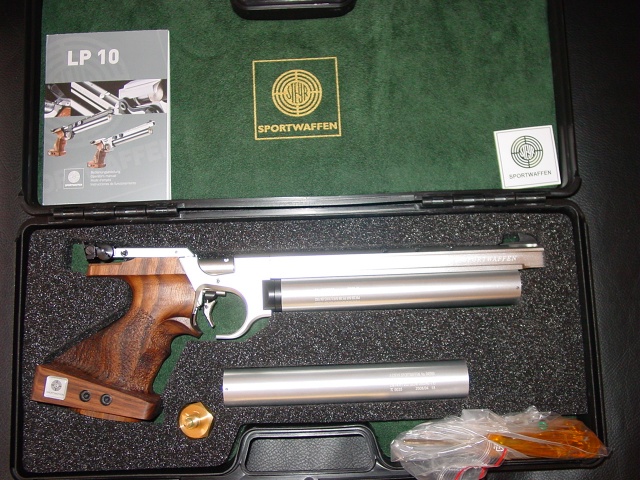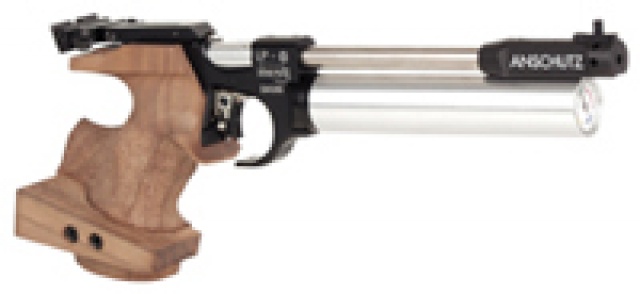Page 2 of 2
Posted: Fri Sep 28, 2007 12:46 pm
by Steve Swartz
Agree with David.
If any data from the chrono is important to accuracy (precision really) that number would be the velocity standard deviations/ranges (measures of velocity spread), not the velocity itself.
Many would argue that for 10m air events, velocity has very little to do with precision.
And velocity spreads have only a little bit more than nothing to do with precision either!
Steve Swartz
Posted: Wed Oct 03, 2007 5:58 am
by jipe
I got an answer from Anschutz about the lower velocity of the LP@ light: it is intentionally factory tuned like that to save air and allow more shots.
This because:
- the cylinder of the LP@ light is smaller and therefore contain less air than the full size cylinder of the LP10 and LP@
- to obtain the same muzzle velocity, more air is needed with the shorter barrel of the LP@ light than what is needed with the longer barrel of the LP10/LP@.
According to Anschutz, it is possible to increase the velocity, but increasing it to the same value as the LP would reduce a lot the number of shots per cylinder.
I must say that the amount of shots possible with the short cylinder of the LP@ light is more than what is expected from the proportion between the normal and short cylinder. Obviously, the LP@ light uses less air per shot than the LP10.
Posted: Wed Oct 03, 2007 7:08 am
by Fred Mannis
jipe wrote:I must say that the amount of shots possible with the short cylinder of the LP@ light is more than what is expected from the proportion between the normal and short cylinder. Obviously, the LP@ light uses less air per shot than the LP10.
The moving mass used to counter recoil in the LP10 uses some air, making the pistol less 'efficient'
Posted: Wed Oct 03, 2007 11:54 am
by jipe
Fred Mannis wrote:jipe wrote:I must say that the amount of shots possible with the short cylinder of the LP@ light is more than what is expected from the proportion between the normal and short cylinder. Obviously, the LP@ light uses less air per shot than the LP10.
The moving mass used to counter recoil in the LP10 uses some air, making the pistol less 'efficient'
The LP@ light has the same frame as the LP@ and the LP10, so it also has that moving mass.
For information (the LP@ light is not so well known), the LP@ ligth has nothing to do with the light pistol of Steyr (the LP2 junior), it is an LP@ with a shorter barrel without holes, shorter cylinder and no additional weigth and bar under the barrel, that's it, all the rest is identical to the LP@.
The LP@ is identical to the LP10 excepted for the barrel, no barrel mantel, the absorber and the additional weights that come on a bar under the barrel instead of being mounted on the barrel mantel.
Posted: Wed Oct 03, 2007 12:10 pm
by David Levene
Just a general question that I can't get my head around at the moment:-
If you have 2 barrels, identical apart from one being shorter, which one would use the most gas to achieve the same muzzle velocity with identical pellets.
Posted: Wed Oct 03, 2007 3:17 pm
by jipe
David Levene wrote:Just a general question that I can't get my head around at the moment:-
If you have 2 barrels, identical apart from one being shorter, which one would use the most gas to achieve the same muzzle velocity with identical pellets.
I have exactly the same question !
The answer from Anschutz is that a shorter barrel needs more gas than a longer one to achieve the same velocity.
As explained above, the comparison of the LP@ light and LP10 doesn't give a real answer because the cylinder of the LP@ light allows more shots than what the volume of air in it would make expect but the velocity is also lower. The only way to compare would be to adjust the velocties so that the two pistol provide the same velocity.
One more parameter: the LP10 (and the normal LP@) has three holes in the barrel to avoid muzzle rise during the shot, while the LP@ light has no holes. I would expect that these holes also consume some air, i.e. that the same lenght of barrel without holes would produce an higher velocity or use less air to achieve the same velocity.
Posted: Wed Oct 03, 2007 5:47 pm
by Steve Swartz
David:
Great question, full of subtleties . . . and Jipe's comment about porting also interesting . . . the answers, as usual, start with "it depends!"
The following random musings are offered humbly as a "thought experiment;" if you are not fascinated by the question (and just want a Yes/No answer) then please skip the following:
- If the longer and shorter barrels were both "long enough" to accelerate the pellet up to speed, then you could get the same velocity out of both for the same amount of gas . . . except that the longer barrel would need slightly more gas to overcome the extra friction!?!
- If both barrels were not "long enough" (ie, pellet still accelerating as it cleared the muzzle, then the reverse would be true- the shorter barrel would need more gas to reacht he same velocity as the longer barrel.
The key is the pressure of the gas is used to overcome frictiona nd accelerate the pellet. As the gas expands behind the pellet, the pressure drops and it produces less acceleration "push." Eventually, the amount of push is not enough to overcome friction, and the pellet (while still moving) actually begins to decelerate. A long enough barrel will actually decelerate the pellet to the point of coming to a dead stop- with the pressure equalized behind and in front of the pellet.
I'm guessing that would have to be a mighty long barrel though!
- As to porting, the answer depends on whether the ports are actually in the barrel or on a sleeve after the muzzle (many compensators act after/as the pellet skirt clears the muzzle). If the "porting" is behind the muzzle, the gas will exhaust prior to pellet clearing, and some velocity will be lost. If the "porting" is after the muzzle, then the gas being vented will not have any effect on velocity. (Engineering note: porting prior ot the muzzle will actually reduce the resistance of the air ahead of the pellet as it travels down the barrel . . . this is most likely negligable compared to the pressure loss at the muzzle end.)
- And we still have to consider the effect of barrel length mentioned in the first two paragraphs. If the parting is behind the muzzle, and the barrel is long enough to result in deceleration, then the porting could actually reduce the "low pressure effect" behind the pellet and actually result in increased velocity.
Now- all of this is theoretical of course- because I don't think typical AP barrels are long enough to ever get to the "deceleration break even" point.
So pretty much the first couple of answers apply: shorter barrels need more gas; ported barrels need more gas.
Sorry for the "theoretical musings!"
Steve Swartz
Posted: Thu Oct 04, 2007 1:17 am
by David Levene
Thanks Steve
Changing the thought priority to "overcoming friction" rather than accelerating "accelerating the pellet" suddenly turns the light on.
My next thought was "what is the optimum barrel length to minimise gas use". This was quickly countered however by " who cares? gas is cheap and I can get over 100 shots from a cylinder".
I occasionally start to think about things like this, and sometimes get to the point of considering experimentation. Luckily I am usually brought back to earth by the fact that it doesn't matter. If the holes are appearing where I expect them then leave well alone.
Thanks again Steve.
Posted: Thu Oct 04, 2007 1:18 am
by jipe
Very good summary Steve.
The LP10 (and LP@) have porting on the barrel itself:

and at the muzzle (to avoid that the turbulences created when the gas leaves the barrel behind the peelt destabilize the pellet).
The LP@ light has no ports in the barrel.

So, the answer would be that the LP@ light needs more air to obtain the same velocity than the LP10 due to its shorter barrel, but difference of air needed is reduced due to the ports of the barrel of the LP10 (the LP10 uses more air than what is normally needed for such a barrel length due to the ports).
Posted: Thu Oct 04, 2007 1:25 am
by David M
Hi Dave
[If you have 2 barrels, identical apart from one being shorter, which one would use the most gas to achieve the same muzzle velocity with identical pellets.]
Work backwards, with identical velocity (V) and pellet mass (M), the exit gas pressure and gas expansion after exit would have to also be identical to give the same kinetic energy (KE=1/2MV2).
Given that the distance (barrel time) to accererate (A) an identical mass is shorter in one instance and that your final velocity is based on time X acceleration, it stands to reason that you need a greater force to achieve that higher acceleration in the shorter barrel. (F=MA)
Cheers
PS I posted a article on chronograhs (as published in Pistol Aust, minus the photo's)
http://www.pilkguns.com/Chrony.shtml[/quote]

